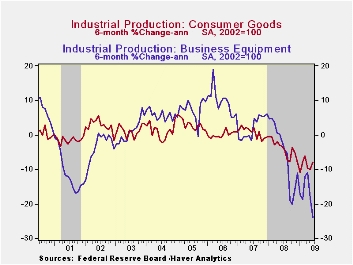 Global| Jul 15 2009
Global| Jul 15 2009U.S. Factory Production Declines Again While Plant Utilization Reaches A Record Low
by:Tom Moeller
|in:Economy in Brief
Summary
Perhaps the decline in industrial production has moderated this year, but it's tough to say for sure given the very erratic size of the month-to-month declines; big one month, small the next. Last month, industrial output which [...]

Perhaps the decline in industrial production has moderated this year, but it's tough to say for sure given the very erratic size of the month-to-month declines; big one month, small the next. Last month, industrial output which includes mining and utilities declined 0.4%. The drop was somewhat less than expected but it followed a large 1.2% May shortfall. That's been the monthly pattern this year. Nevertheless, so far output has declined at a 13.2% annual rate which is near this cycle's worst rate of decline reached last January of -17.8%.
Output of consumer goods overall slipped just 0.3% during June but the rate of decline in 2009 amounted to 8.0%, near the worst for the cycle. Last month, production of autos fell 2.7% following the 8.2% May decline. Furniture output also fell a hard 0.7% and at a 19.7% rate in 2009 as consumers continue to defer purchases of large durable goods. Apparel output fell a whopping 4.9% and it's down at a 21.7% rate this year while output of business equipment fell 0.8%. The 23.9% six-month rate of decline here is the worst since 1958. The output of construction supplies fell just 0.1% but this year it's down at an 18.0% rate, versus -31.2% at its weakest.
In the the high-tech sector the rate of decline in output also has slowed ... maybe. Industrial production fell 1.0% last month and at a reduced 9.8% rate for all of this year. Less high tech, overall industrial production fell a reduced 0.3% last month and the annual rate of change eased to -13.3% over the last six months.
Outside of the auto and high-tech sectors, output declines also have yet to moderate much. Here output fell 0.3% last month and at an 11.6% rate this year. That's against the worst six-month rate of decline recently reached of -14.9%.
Excess capacity grew even further last month. Capacity utilization fell to a record low of 68.0%. The series dates back to 1966. In the factory sector the figures indicate that there's even more slack. Utilization in the factory sector dropped even harder to 64.6% from a peak near 80% back in 2007. The latest rate was a record low since WW II.
The industrial production data are available in Haver's USECON database.
| INDUSTRIAL PRODUCTION (SA, %) | June | May | Y/Y | 2008 | 2007 | 2006 |
|---|---|---|---|---|---|---|
| Total Output | -0.4 | -1.2 | -13.6 | -2.2 | 1.5 | 2.3 |
| Manufacturing | -0.5 | -1.2 | -15.5 | -3.2 | 1.4 | 2.5 |
| Consumer Goods | -0.3 | -1.0 | -7.9 | -2.6 | 0.9 | 0.4 |
| Business Equipment | -0.8 | -1.9 | -17.8 | -1.1 | 2.7 | 9.4 |
| Construction Supplies | -0.1 | -0.4 | -20.6 | -6.3 | -2.0 | 2.3 |
| Utilities | 0.7 | -1.3 | -3.9 | 0.3 | 3.4 | -0.6 |
| Capacity Utilization | 68.0 | 68.2 | 78.7 (June '08) | 77.6 | 80.6 | 80.9 |
Tom Moeller
AuthorMore in Author Profile »Prior to joining Haver Analytics in 2000, Mr. Moeller worked as the Economist at Chancellor Capital Management from 1985 to 1999. There, he developed comprehensive economic forecasts and interpreted economic data for equity and fixed income portfolio managers. Also at Chancellor, Mr. Moeller worked as an equity analyst and was responsible for researching and rating companies in the economically sensitive automobile and housing industries for investment in Chancellor’s equity portfolio. Prior to joining Chancellor, Mr. Moeller was an Economist at Citibank from 1979 to 1984. He also analyzed pricing behavior in the metals industry for the Council on Wage and Price Stability in Washington, D.C. In 1999, Mr. Moeller received the award for most accurate forecast from the Forecasters' Club of New York. From 1990 to 1992 he was President of the New York Association for Business Economists. Mr. Moeller earned an M.B.A. in Finance from Fordham University, where he graduated in 1987. He holds a Bachelor of Arts in Economics from George Washington University.






